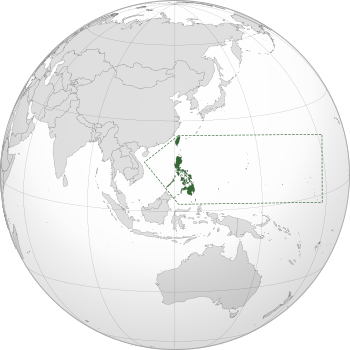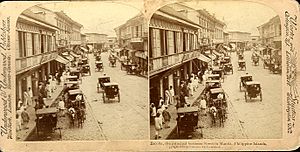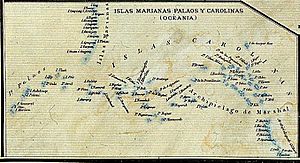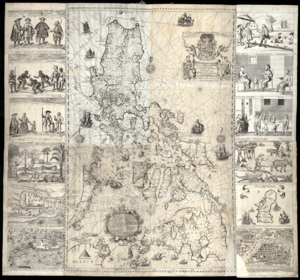Spanish East Indies facts for kids
Quick facts for kids
Spanish East Indies
Indias orientales españolas
|
|||||||||||||||||||||||||||||||||||||||||||||||
|---|---|---|---|---|---|---|---|---|---|---|---|---|---|---|---|---|---|---|---|---|---|---|---|---|---|---|---|---|---|---|---|---|---|---|---|---|---|---|---|---|---|---|---|---|---|---|---|
| 1565–1898 | |||||||||||||||||||||||||||||||||||||||||||||||
|
Motto: Plus Ultra
"Further Beyond" |
|||||||||||||||||||||||||||||||||||||||||||||||

Spanish East Indies
|
|||||||||||||||||||||||||||||||||||||||||||||||
| Status | Territories of Spain (Territory of New Spain from 1565 to 1821, and province of Spain from 1821 to 1898) |
||||||||||||||||||||||||||||||||||||||||||||||
| Capital | |||||||||||||||||||||||||||||||||||||||||||||||
| Common languages | Spanish (official) Philippine languages, Micronesian languages, Kavalanic East Formosan languages, Hokkien |
||||||||||||||||||||||||||||||||||||||||||||||
| Religion | Roman Catholicism (state religion), Islam, Philippine traditional religion, Micronesian traditional religion, Taiwanese aboriginal traditional religion, Overseas Chinese folk religion |
||||||||||||||||||||||||||||||||||||||||||||||
| Monarch | |||||||||||||||||||||||||||||||||||||||||||||||
|
• 1565–1598 (first)
|
Philip II | ||||||||||||||||||||||||||||||||||||||||||||||
|
• 1886–1898 (last)
|
Alfonso XIII | ||||||||||||||||||||||||||||||||||||||||||||||
| Governor-General | |||||||||||||||||||||||||||||||||||||||||||||||
|
• 1565–1572 (first)
|
Miguel López de Legazpi | ||||||||||||||||||||||||||||||||||||||||||||||
|
• 1898 (last)
|
Diego de los Ríos | ||||||||||||||||||||||||||||||||||||||||||||||
| Legislature | Cortes Generales | ||||||||||||||||||||||||||||||||||||||||||||||
| Historical era | Spanish Empire | ||||||||||||||||||||||||||||||||||||||||||||||
|
• Colonization
|
27 April 1565 | ||||||||||||||||||||||||||||||||||||||||||||||
|
• East Indies colony established
|
28 September 1821 | ||||||||||||||||||||||||||||||||||||||||||||||
|
• Philippine declaration of independence
|
12 June 1898 | ||||||||||||||||||||||||||||||||||||||||||||||
| 10 December 1898 | |||||||||||||||||||||||||||||||||||||||||||||||
| 12 February 1899 1898 | |||||||||||||||||||||||||||||||||||||||||||||||
| 23 March 1901 | |||||||||||||||||||||||||||||||||||||||||||||||
| Area | |||||||||||||||||||||||||||||||||||||||||||||||
| 1877 | 345,155 km2 (133,265 sq mi) | ||||||||||||||||||||||||||||||||||||||||||||||
| Population | |||||||||||||||||||||||||||||||||||||||||||||||
|
• 1877
|
5,567,685 | ||||||||||||||||||||||||||||||||||||||||||||||
| Currency | Spanish dollar, Spanish peseta | ||||||||||||||||||||||||||||||||||||||||||||||
|
|||||||||||||||||||||||||||||||||||||||||||||||
The Spanish East Indies (Spanish: Indias orientales españolas [ˈindjas oɾjenˈtales espaˈɲolas]; Filipino: Silangang Indiyas ng Espanya) were the overseas territories of the Spanish Empire in Asia and Oceania from 1565 to 1898, governed for the Spanish Crown from Mexico City and Madrid through the captaincy general which ruled Manila.
The King of Spain traditionally styled himself "King of the East and West Indies (in Spanish: Rey de las Indias orientales y occidentales)".
From 1565 to 1821 these territories, together with the Spanish West Indies, were administered through the Viceroyalty of New Spain based in Mexico City. After independence of the Mexican Empire, they were ruled directly from Madrid. The territories ruled included present-day Philippines, Guam and the Mariana Islands, as well as Palau, part of Micronesia and for a brief period Northern Taiwan and parts of North Sulawesi and the Moluccas. Cebu was the first seat of government, which later transferred to Manila.
As a result of the Spanish–American War in 1898, the United States occupied the Spanish Philippines and Guam, while Spain sold other smaller islands to Germany in the German–Spanish Treaty of 1899. The few remaining islands were ceded to the United States when the Treaty of Washington was ratified in 1901.
Contents
History
Exploration and Settlement (1521–1643)
With the Portuguese guarding access to the Indian Ocean around the Cape, a monopoly supported by papal bulls and the Treaty of Tordesillas, Spanish contact with the Far East waited until the success of the 1519–1522 Magellan–Elcano expedition that found a Southwest Passage around South America into the Pacific. The expedition reached the outskirts of the East Indies on 6 March 1521, sighting the Marianas. Upon reaching the Philippines, Magellan was able to convert and ally with Humabon, raja of Cebu, but died shortly thereafter in the Battle of Mactan while trying to shore up Humabon's control over nearby islands. When the expedition's new leaders refused to honor Magellan's will and free his Malay slave Enrique, Enrique—who also acted as their interpreter—was able to turn Humabon against them, provoking a massacre of the Spanish on 1 May. Consolidated onto the Trinidad and the Victoria, the survivors were able to reach the city-state of Tidore in the Spice Islands on 8 November. Its sultan Al-Mansur promptly pledged his realm as Spain's vassal the next day, hoping to use them as a counterweight to Portuguese support of his rival Bayan Sirrullah of Ternate. Within a year, he was joined in this by Yusuf, sultan of Jailolo on nearby Halmahera. In the event, though, Portuguese under Antonio de Brito forced Al-Mansur to surrender the Spaniards who had stayed in his realm and abjure any connection to Spain on 14 May 1522, the Victoria limped back to Spain to complete the first circumnavigation of the globe on September 6th, the Trinidad surrendered herself to De Brito to avoid starvation in November, and Charles I signed away any of his interests in the East Indies for 350,000 ducats in the Capitulation of Zaragoza on 22 April 1529.
Seeking to develop trade between the East Indies and the Americas across the Pacific Ocean, Antonio de Mendoza encouraged the exploration of these Asian territories and commissioned the expedition of his in-law Ruy López de Villalobos to the Philippines in 1542–1543. Miguel López de Legazpi set out from Mexico, and established the first Spanish settlement in the Philippines in 1565, which became the town of San Miguel in present-day Cebu. That same year, another member of the expedition, Andrés de Urdaneta, discovered a maritime route from the Philippines to Mexico, across the Pacific, leading to the important transpacific transport link of the Manila-Acapulco Galleons.
In 1571, exploiting a rivalry between the states of Tondo and Maynila, the later being a city-state established by Bruneian Muslim colonists, meant to supplant Tondo, the Spaniards captured Maynila and renamed it Manila, a former satellite-state of the Brunei Sultanate and then Manila was made the seat of the Spanish Captaincy General of the Philippines. The Hindu Rajahnate of Butuan and the Kedatuans of Dapitan and Madja-as willingly joined the Spaniards to ally against their common Muslim rivals (Spain recently expelled the Muslims who invaded their homeland at the culmination of the Reconquista), Zamboanga was also taken from the Sultanate of Sulu via the efforts of Spanish and Peruvian soldiers and native allies as all these territories were incorporated into the Spanish East Indies.
The Philippines became the center of operations for further Spanish wars in Asia including the Castilian War against the Sultanate of Brunei, raids against the Ottoman protectorate of the Sultanate of Aceh, the brief conquests of the Sultanates of Tidor and Ternate as well as Spanish campaigns into Cambodia and Taiwan. These and other Asian territories claimed by the Spanish crown were to be governed from the Viceroyalty of New Spain in Mexico City.
The Manila-Acapulco galleons shipped products gathered from both Asia-Pacific and the Americas, such as silk, spices, silver, gold and other Asian-Pacific islander products to Mexico. Products brought from Asia-Pacific were sent to Veracruz and shipped to Spain and, via trading, to the rest of Europe, while Spanish-Mexican navigators brought with them Hispanic and indigenous Mexican customs, religion, languages, foods, and cultural traditions to the Philippines, Guam, and the Mariana Islands.
In 1606, the Spaniards established trade links with the Maluku Islands, which continued until 1663. Contacts with Japan were also established and Sebastián Vizcaíno was sent as ambassador in 1611, until Japan closed its trading post in 1630. In northeastern Taiwan, the Spaniards built Fort Santo Domingo near Keelung in 1626 and a mission in Tamsui in 1628, which they occupied until they lost in the Second Battle of San Salvador. Several Pacific islands were visited by Spanish ships in the 16th century, including New Guinea (Yñigo Ortiz de Retez in 1545), the Solomon Islands (Pedro Sarmiento de Gamboa in 1568), and the Marquesas Islands (Álvaro de Mendaña de Neira in 1595), but they made no effort to trade with or colonize them.
In 1668, Blessed Diego Luis de San Vitores established the first mission on Guam, where he and Saint Pedro Calungsod were later martyred.
In 1762 British troops briefly captured the city of Manila as well as Bulacan, Pampanga, and parts of Ilocos for two years during the Seven Years' War. Through the efforts of the Spanish authorities along with help from local forces, they unsuccessfully resisted the British bombardment. There were also rebellions by local leaders such as Diego Silang and his wife Gabriela who held support for Britain. Under the peace settlement Manila was exchanged, along with British-occupied Havana, for Florida and Menorca. Manila was ceded back to Spanish authorities in April 1764.
Colonial government

The Seven Years' War prompted Charles III to initiate extensive governmental reforms throughout the overseas possessions. An intendencia was established in Manila in 1784 to handle the government finances and to promote the economy. (The plan to introduce more intendencias throughout the Philippines did not materialize.) In a similar vein, to promote innovation and education among the residents of the islands, Governor-General José Basco y Vargas established the Economic Society of the Friends of the Country.
For over 256 years, the Spanish East Indies were governed by a governor-captain general, and an audiencia. All economic matters of the Philippines were managed by the Viceroyalty of New Spain, located in Mexico. Because the eastward route was more widely used for military purposes, in addition to commerce that included the Manila-Acapulco galleon trade, most government correspondence went through Mexico, rather than directly to Spain (with the exception of a short period at the end of the 18th century).
In 1821, the New Spanish Viceroyalty collapsed following the Mexican War of Independence, which resulted in the First Mexican Empire. All control of the Spanish East Indies government was then transferred to Madrid, until the United States annexed most Spanish territories in the Asia-Pacific region after the Spanish–American War of 1898.
The Audiencia and Captaincy General
In 1574 the Captaincy General of the Philippines was created as a dependency of the Viceroyalty of New Spain. The Real Audiencia of Manila was created on 5 May 1583 and the first session was held on 15 June 1584 as the highest tribunal of the Spanish Empire in the East Indies, that had the Governor-General of the Philippines as its ex officio highest judge. Both institutions were created by Royal Decree from King Felipe II
Law XI (Audiencia y Chancillería Real de Manila en las Filipinas) of Title XV (De las Audiencias y Chancillerias Reales de las Indias) of Book II of the Recopilación de Leyes de los Reynos de las Indias of 1680—which compiles the original decree and the one of 25 May 1596—describes the limits and functions of the Audiencia and its president.
"In the city of Manila on the Island of Luzon, Head of the Philippines, shall reside another Royal Audiencia and Chancellery of ours, with a president, who shall be governor and captain general; four judges of civil cases [oidores], who will also be judges of criminal cases [alcaldes del crimen]; a crown attorney [fiscal]; a bailiff [alguacil mayor]; a lieutenant of the Gran Chancellor; and the other necessary ministers and officials; and which shall have for district said Island of Luzon, and the rest of the Philippines, the Archipelago of China, and its Mainland, discovered and to be discovered. And we order that the governor and captain general of said Islands and Provinces, and president of their Royal Audiencia, have exclusively the superior government of the entire district of said Audiencia in war and peace, and shall make provisions and favors in our Royal Name, which in conformity to the laws of this Compilation and the rest of the Kingdoms of Castile and the instructions and powers that We shall grant, he should and can do; and in gubernatorial matters and cases that shall arise, that are of importance, said president-governor should consult on them with the judges of said Audiencia, so that they give their consultive opinions, and having heard them, he should provide the most convenient to the service of God and ours and the peace and tranquility of said Province and Republic".
Territories
The Spanish East Indies came to be defined as:
- Las Islas Filipinas (today the Republic of the Philippines): Manila, Luzon, the Visayas, Palawan, Balambangan Island, Northern Mindanao, Zamboanga, Basilan, Jolo, Palmas Islands, Spratly Islands; including isolated outposts in Keelung, Taiwan, and in the islands of Gilolo, Ternate, and Tidore in the Maluku Islands and Manado in Northern part of Sulawesi (formerly Celebes).
- Islas Carolinas (the Federated States of Micronesia)
- Islas Marianas (Commonwealth of the Northern Mariana Islands and the United States Territory of Guam)
- Islas Palaos (Republic of Palau)
The timeline of the territories ruled by Spain included:
- the Captaincy General of the Philippines (1565–1898) (now the Philippines).
- Palau (1574–1899).
- the Marianas (1667–1898 or 1899) (now Guam and Northern Mariana Islands).
- the Carolines (Nuevas Filipinas) (1686–1899) (now the Federated States of Micronesia).
- the Marshall Islands (1874–1885).
- parts of Formosa (now Taiwan) (1626–1642).
- parts of Sulawesi (Celebes) and of the Moluccas (Maluku Islands) (1580–1663) (now parts of Indonesia).
The Spanish used several names that are not currently used. Gran Moluca (Great Molluccas) for the island of Mindanao and Nueva Castilla (New Castile) for Luzon.
Because Spanish interest in the region was primarily focused on its use as a base for trade with East Asia, direct Spanish control over the area expanded slowly. The Batanes Islands were conquered in the 18th century by José Basco. The highlands of Luzon remained outside Spanish control until the early 19th century, and the southernmost tip of Palawan, not until the late 1890s. The rest of Mindanao (Caesarea Karoli)—aside from outposts in Northern Mindanao, Zamboanga, Cotabato, and the islands of Basilan and Jolo, the rest was nominally under Spanish control, recognizing Spanish rule, but left to administer their own affairs, as in the cases of the Sulu, and the Maguindanao sultanates, as well as a number of other Lumad tribes not affiliated with either. Similarly, Palau and the vast majority of the Caroline Islands were not governed by Spanish missions until the early 19th century.
Cultural influence in the former Spanish East Indies
Hispanic
Spain's influence on its former territories in Asia-Pacific is significant to this day. The majority of the people of the Philippines, Guam and the Mariana Islands belong to the Roman Catholic faith which was introduced by Spanish missionaries in the 16th and 17th centuries. A large part of the population in these countries were forced to use Spanish names and surnames, many of which are still in use. Also, because of the introduction of new tools, products, crops and technology by Spaniards and Mexicans in the three centuries of colonial rule, many Spanish loanwords entered the native languages of these countries. Art forms such as music, architecture and fashion also have much Spanish influence. The national cuisines of these countries also have a few Mexican and Spanish elements.
Filipino
A sizeable proportion of the current population of the Northern Marianas Islands (45–55%) and Guam (30–45%), as well as that of Palau (15–25%) is of Filipino descent. Some of the local peoples in the previously stated territories also use Filipino names and surnames (one example is the surname Pangelinan, which comes from the Filipino surname Pangilinan). The current Chamorro population is believed to be partly of Filipino descent, both because of the historic links between Guam, and the Northern Mariana Islands and the Philippines during Spanish rule, and currently through different waves of migration. The cuisines of Guam, the Northern Mariana Islands, and Palau are also heavily influenced by Filipino cuisine, with dishes like Pancit, Lumpia, Kelaguen, Halo-halo and Okoy being the most noticeable.
See also
 In Spanish: Imperio español en Asia y Oceanía para niños
In Spanish: Imperio español en Asia y Oceanía para niños
- Spanish Filipino
- Dutch East Indies
- Captaincy General of the Philippines







